Due to the El Niño phenomenon, Costa Rica experienced lower than normal rainfall in 2023 across most of the country, ending the year with a precipitation deficit in almost all regions.
The National Emergency Commission (CNE) is urging residents to limit water usage in the coming months. “This phenomenon will continue. Experts predict drought conditions early in 2024, impacting agriculture, energy, and worsening conditions,” said CNE President Alejandro Picado.
According to the National Meteorological Institute (IMN), El Niño will peak between December and January. Projections show limited time for it to become an extraordinary El Niño event, as seen in 2015 or 1997. For now, it remains a strong event with adverse impacts.
Since October, the CNE has elevated the national alert status from green to yellow due to El Niño. A drier than normal dry season is expected, with temperatures 0.5-1°C higher than average.
“Rainfall in recent months has been insufficient for what watersheds truly require,” said Eladio Solano, Head of Forecasting at IMN. “In general, rains were scarce across Costa Rica, linked to El Niño which dominated the 2023 rainy season,” he added.
However, some extreme rain events led to excess rainfall in parts of the North Pacific coast, another characteristic of the phenomenon. “It was a challenging year, significantly impacting small farmers and ranchers,” said Guanacaste resident Jeiner Flores.
The Central Pacific, South Pacific, Central Valley, Caribbean coast and Northern Zone face significant meteorological drought. AyA estimates the most affected areas in 2024 could be the North Pacific, Northern Zone, Caribbean, Chorotega region, and Greater Metropolitan Area.






